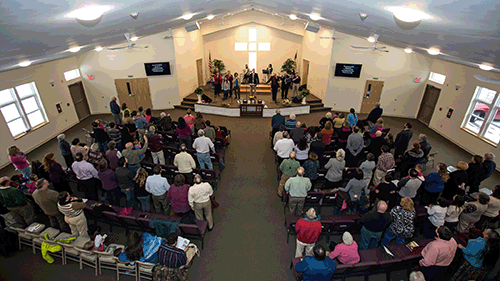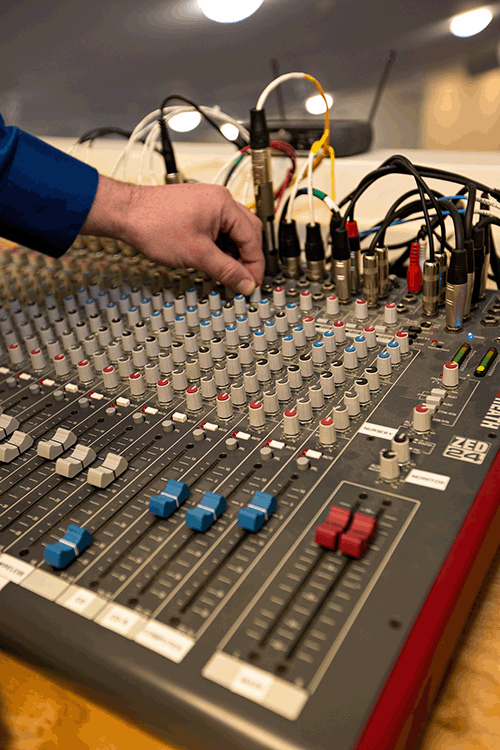New England Church Combines New with Old to Meet Ambitious AV Goals

Located in Standish, ME, about 40 minutes west of Portland, The Living Stone Community Baptist Church is considered a large church in New England. But large is a matter of perspective. It’s not large when compared to the mega-churches that often grab headlines, but with a congregation of about 800, it is considered to be above average. Still, being “large by comparison” doesn’t necessarily translate into large budgets. So when Pastor Joey Marshall was building a new a 10,000-square-foot church that would serve the Living Stone congregation for many years to come, he turned to a trusted source to install an AV system: John DeGange, of DeGange Sound Solutions.
A balcony shot of the sanctuary.
DeGange, a 23-year industry veteran, started his own installation business in 2011 after the closing of the Daddy’s Junky Music Store. “I had been the manager of their commercial installation division, so it seemed a logical move to open my own AV/lighting installation business," he said. "Working with house of worship and education customers that had always been the bread and butter of our business, and working for myself would allow me to continue to serve those markets.”
DeGange had a history with Pastor Joey. “This was the third church installation which I’d worked on with the pastor,” said DeGange. “We had been expanding the system for each enlargement of the church since the beginning, so there was already a level of understanding and trust. He called me early in the new building’s planning process to talk about his short-term needs and future goals and develop a plan. We determined that using the most or all of the existing sound gear would be sufficient. Because the pastor wanted to increase the use of video now and be able to expand its use down the road, I suggested wiring the entire building with category cable during the building process. Then we sat down with the electricians and network wiring companies to lay out all the locations where we’d want video now and in the future.”
The vision, according to Pastor Joey, was “a facility that would meet our needs not only today, but 50 years from now.” This meant incorporating technology into all areas of the new building, including the multipurpose space, the preschool, and the children and youth ministry rooms. It meant, according to Pastor Joey, “making sure we were wired not only spiritually, but physically as well, by employing the latest technologies to help us meet our goals.”
- The church’s immediate needs dealt with outfitting the 3,600-square-foot sanctuary. Much of the audio system was being carried over from the previous location, including an Allen & Heath analog soundboard and QSC audio system. And they would have to add additional new QSC speakers.
But the video system would be new, with two 60-inch flat panel displays mounted in front of the room facing the congregation, as well as a third 60-inch confidence monitor mounted in the rear facing the pulpit. The three video displays would be served by the church’s two existing laptop computers, which presented two challenges: connecting the computers’ VGA outputs to the displays’ HDMI inputs, and how to control the content being supplied to each.

The soundboard at Living Stone Church.
A daily selection of the top stories for AV integrators, resellers and consultants. Sign up below.
DeGange saw these as the installation’s major technical challenges. And to meet them, he chose a family of products from Atlona: the AT-HD500 converter/scaler for converting the VGA signals to HDMI, eight AT-HDRX-IR receivers, and an AT-HDCAT-8, an AV switch with two HDMI inputs, eight HDBaseT outputs, and one HDMI output.
The HDCAT offered several advantages: first, it would not only provide a cost-effective solution for handling the immediate need of distributing the signals from multiple sources to multiple destinations, but the additional, unused outputs would provide future distribution to the multipurpose space, preschool and the ministry rooms that were already being pre-wired for later inclusion. But just as importantly, the HDCAT’s use of HDBaseT technology would support the long cable runs they would need and still deliver superb image quality.
All three displays in the sanctuary were outfitted with the Atlona IR receivers, and according to DeGange, the plan is to use the additional receivers as more TVs are added. There are 10 other drop locations available in various rooms in the church, and while peripheral rooms in the church were still under construction at the time of install, all the locations have already been tested so video and audio can be dropped in very easily as circumstances allow.
DeGange also noted that he and the pastor have already developed a longterm plan for the HDCAT to be replaced at some later date for a matrix to support more sources being added to the system, while still using the current AT-HDCAT-8 for locations that would all have the same content. “All of this was determined in the planning stage of the project so we could maximize our investments through a ‘no loss of equipment’ strategy as the system expanded,” DeGange said.

Pastor Joey Marshall and John Degange
According to DeGange, the system worked perfectly from the get-go. “We had no glitches, no gremlins, no surprises what so ever,” he said. He credited Atlona’s video test kit for allowing him to quickly test all his wiring to every location to know all his connections were 100 percent. “That was a great investment,” he said.
In the world of worship, success is often a matter of signs and faith. Asked how the church’s system has performed so far, DeGange said, “I haven’t heard a peep from the pastor since installation. And if I don’t hear from him until the next phase of the project, that will be the best sign of all.”
